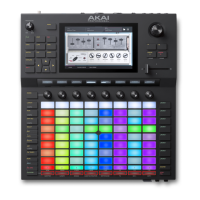
Do you have a question about the Akai FORCE and is the answer not in the manual?
| Control type | Touch |
|---|---|
| Product color | Black |
| Drum pads backlight | Yes |
| Number of drum pads | 64 |
| USB direct playback | - |
| Built-in optical drive | No |
| Display type | LED |
| Display diagonal | 6.9 \ |
| Headphone outputs | 1 |
| USB connector type | USB Type-A, USB Type-B |
| USB ports quantity | 3 |
| Headphone connectivity | 6.3 mm |
| Compatible memory cards | SD |
| Current | 3.42 A |
| Input voltage | 19 V |
| Power supply type | DC |
| Cable lock slot type | Kensington |
| Depth | 389 mm |
|---|---|
| Width | 350 mm |
| Height | 72.5 mm |
| Weight | 3870 g |
Crucial safety and setup advice before operating the Force hardware.
Illustrates typical hardware connections for the Force unit.
Guides users through basic tasks using a provided demo project.
Instructions for renaming tracks and clips using the virtual keyboard.
Navigating and loading samples, clips, and instruments from storage.
Adjusting track levels, panning, and assignments in the mixer.
Previewing tracks using headphones before sending to the main mix.
Guides on creating new scenes and empty clips for recording.
Introduces Drum, Melodic, and Lanes modes for step sequencing.
Introduces the chapter on complete device features and operation.
Introduces Launch, Note, and Step Sequencer modes for the 8x8 pad grid.
Details how to access modes, save projects, and adjust preferences.
How to access and utilize the device's preferences settings.
Explains the two operating modes and how to switch between them.
Settings for quantizing note events and audio track regions.
Settings for the metronome's count-in, sound, rate, and output.
How to write, read, or disable track automation.
Introduces the arpeggiator and phrase player functions.
Introduces the included AIR Music Technology plugins.
Introduces the Hype plugin and its macro controls.
Explains HP Filter, HP Filter Sweep, HP Filter Sync, LP Filter, LP Filter Sweep.
Parameters for AIR Para EQ, PEQ 2-Band, and PEQ 4-Band equalizers.
Lets users edit samples using various functions like trimming and naming.
Cropping start and end points from samples, including loop functions.
Assigning new samples directly to a pad from Trim Mode.
Selecting editing options like Discard, Delete, Silence, Extract, Normalize.
Converting slices into new drum tracks or assigning them to pads.
Dividing samples into multiple regions (slices) using various methods.
Capturing and converting presets into keygroup sampler patches.
Recording and overdubbing audio in real-time for live performance.
Setting levels, panning, and other settings for tracks, returns, and masters.
Setting levels, panning, and other settings for individual pads.
Assigning specific colors to pads and setting pad light display modes.
Lists available effects and provides details on their parameters.
Parameters for Flanger and Flanger Sync effects.
Parameters for AIR Multi-Chorus and Chorus 2/4-Voice effects.
Parameters for Autopan and Tremolo effects.
Parameters for Phaser and Phaser Sync effects.
Explains HP Filter, HP Filter Sweep, HP Filter Sync, HP Shelving Filter.
Explains LP Filter, LP Filter Sweep, LP Filter Sync, LP Shelving Filter.
Explains AIR Filter Gate and AIR Filter effects.
Parameters for AIR Para EQ, PEQ 2-Band, and PEQ 4-Band equalizers.
Instructions for installing a SATA drive for increased internal storage.
Setting up Force to send and receive MMC messages for transport controls.
Details mechanical, memory, file system, connections, power, and dimensions.